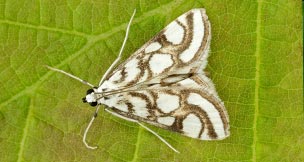Moth Night is the UK’s annual celebration of moths and moth recording, a chance for naturalists to raise the profile of these much-maligned creatures, for conservationists to gather useful data and for members of the public to experience the dazzling diversity of these important insects.
Compared to just 57 resident species of butterflies, over 2,500 different types of moths have been recorded in the UK, playing vital roles in food chains and as pollinators of wild plants. Moth Night 2018 takes place on the three days and nights of 14 – 16 June and is a great opportunity to learn more about these insects, find out which species are visiting your garden and contribute to citizen science by submitting your sightings. See below for some ideas of how to get involved.
Each year, Moth Night has a different theme and this time the event, organised by Atropos, Butterfly Conservation and theCentre for Ecology & Hydrology, is focussed on pyralids, a group of micro-moths. Although ‘micros’ are often portrayed as boring, brown and impossible to identify, pyralids explode these myths, with simply stunning species such as the threatened Scarce Crimson and Gold, long-distance migrants such as the Rusty-dot Pearl and amazing lifestyles, such as the Beautiful China-mark with its caterpillars that live under water in rivers, streams and ponds.
How to get involved in Moth Night 2018
Although pyralids are the specific theme of this year’s Moth Night, sightings of all moths are extremely welcome. June is a great time of year for moths with many species on the wing, including spectacular hawk-moths, bright-yellow Brimstone Moths and the fabulous Buff-tip, which closely resembles a snapped Silver Birch twig. Although it doesn’t get dark until late, many pyralids and other moths are active in the day, so you can find and record these too.
Here are some ideas for a moth-tastic Moth Night.
- Mint and Magpie – two pyralid species to look out for in the garden during the day are the Mint Moth Pyrausta aurata, a small (wing length c.1cm), day-flying moth with purple-brown wings with golden spots and stripes, typically found around herbs such as mints and oregano, and the black and white spotted Small Magpie Anania hortulata, often disturbed from nettle beds, which has a wingspan of over 3cm, similar in size to a Holly Blue butterfly.
- Leave a light on. Specially designed moth-traps are an excellent way of attracting a large variety of moths, but you can also lure moths just to a lighted window or outside light.
- Take a torch-light safari. Like butterflies, most moths visit flowers to drink nectar, so checking plants that are popular with daytime visitors will often also reveal moths at night. In addition, some plants specifically attract nocturnal pollinators, releasing their fragrance and producing nectar at night, such as Stocks, Jasmine, Honeysuckle, Evening Primrose and Phlox, so be sure to check these.
- Attend a public event. Many organisations put on special events for Moth Night, which might be a guided walk to look for day-flying species, a morning event to look at the moths caught overnight or, an evening around the moth-trap, seeing moths as they arrive and with experts on hand to help with identification.
- Record moths somewhere new. If you are already an enthusiastic moth recorder, take the opportunity to visit a new site to record moths or organise a moth-trapping event for family or friends.
- Join the social whirl. Post pictures of your mothy finds on Facebook, Twitter or Instagram using #MothNight - we can help with identifications and you can see what other people have discovered.
- Send in your sightings. Whatever you do, please ensure that you submit your sightings via the online recording form on the Moth Night website, so that we can build up a picture of all the activity and records during the event (all records are subsequently passed on to County Moth Recorders).
Richard Fox
Associate Director Recording and Research, Butterfly Conservation
Image captions:
Caterpillars of the Beautiful China-mark Nymphula nitidulata live underwater feeding on Water-lily and other aquatic plants. The adult moth flies at night but can also be spotted on vegetation near ponds and rivers in the daytime.
The Scarce Crimson and Gold Pyrausta sanguinalis is a rare and threatened species in the UK. Although it is now thought to be extinct in Britain, a few colonies still exist along the coast of Northern Ireland. (Image by Robert Thompson)
Despite its tiny size, the Rusty-dot Pearl Udea ferrugalis is a long-distance migrant, arriving in the UK each year, sometimes in large numbers, from warmer parts of Europe. It can be found in all parts of the UK and although it is nocturnal, it is often seen during the day when disturbed from its hiding places.


